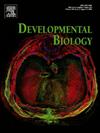Post-eclosion growth in the Drosophila ejaculatory duct is driven by Juvenile hormone signaling and is essential for male fertility
IF 2.5
3区 生物学
Q2 DEVELOPMENTAL BIOLOGY
引用次数: 0
Abstract
The Drosophila Ejaculatory duct (ED) is a secretory tissue of the somatic male reproductive system. The ED is involved in the secretion of seminal fluid components and ED-specific antimicrobial peptides that aid in fertility and the female post-mating response. The ED is composed of secretory epithelial cells surrounded by a layer of innervated contractile muscle. The ED grows in young adult males during the first 24 h post-eclosion, but the cell cycle status of the ED secretory cells and the role of post-eclosion ED growth have been unexplored. Here, we show that secretory cells of the adult Drosophila ED undergo variant cell cycles lacking mitosis called the endocycle, that lead to an increase in the cell and organ size of the ED post eclosion. The cells largely exit the endocycle by day 3 of adulthood, when the growth of the ED ceases, resulting in a tissue containing cells of ploidies ranging from 8C to 32C. The size of the ED directly correlates with the ploidy of the secretory cells, with additional ectopic endocycles increasing organ size. When endoreplication is compromised in ED secretory cells, it leads to reduced organ size, reduced protein synthesis and compromised fertility. We provide evidence that the growth and endocycling in the young adult male ED is dependent on Juvenile hormone (JH) signaling and we suggest that hormone-induced early adult endocycling is required for optimal fertility and function of the ED tissue. We propose to use the ED as a post-mitotic tissue model to study the role of polyploidy in regulating secretory tissue growth and function.

果蝇射精管的羽化后生长是由幼年激素信号驱动的,对雄性生殖能力至关重要。
果蝇射精管(ED)是雄性生殖系统的一个分泌组织。ED参与精液成分和ED特异性抗菌肽的分泌,有助于生育和雌性交配后反应。ED由分泌性上皮细胞组成,周围是一层受神经支配的收缩肌。在羽化后的第一个24小时内,年轻成年男性的ED生长,但ED分泌细胞的细胞周期状态和羽化后ED生长的作用尚未被探索。在这里,我们发现成年果蝇ED的分泌细胞经历了缺乏有丝分裂的不同细胞周期,称为内周期,这导致ED在羽化后的细胞和器官大小增加。在成年期的第3天,当ED停止生长时,细胞大部分退出内循环,导致组织中包含倍数从8C-32C不等的细胞。ED的大小与分泌细胞的倍性直接相关,额外的异位内环增加了器官的大小。当ED分泌细胞的内复制受损时,它会导致器官大小缩小,蛋白质合成减少和生育能力受损。我们提供的证据表明,年轻成年男性ED的生长和内环化依赖于少年激素(JH)信号,我们认为激素诱导的成年早期内环化是ED组织最佳生育和功能所必需的。我们建议使用ED作为有丝分裂后的组织模型来研究多倍体在调节分泌组织生长和功能中的作用。
本文章由计算机程序翻译,如有差异,请以英文原文为准。
求助全文
约1分钟内获得全文
求助全文
来源期刊

Developmental biology
生物-发育生物学
CiteScore
5.30
自引率
3.70%
发文量
182
审稿时长
1.5 months
期刊介绍:
Developmental Biology (DB) publishes original research on mechanisms of development, differentiation, and growth in animals and plants at the molecular, cellular, genetic and evolutionary levels. Areas of particular emphasis include transcriptional control mechanisms, embryonic patterning, cell-cell interactions, growth factors and signal transduction, and regulatory hierarchies in developing plants and animals.
 求助内容:
求助内容: 应助结果提醒方式:
应助结果提醒方式:


